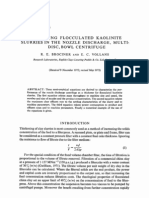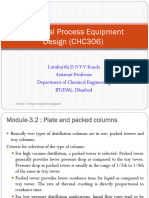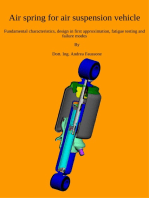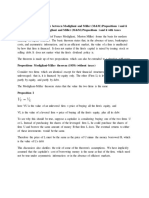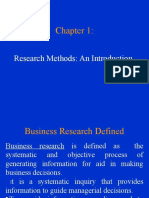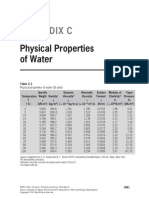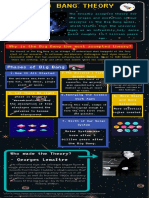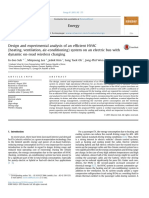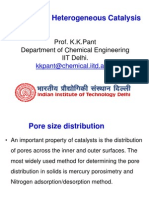CRD
CRD
Uploaded by
Samuel AbebawCopyright:
Available Formats
CRD
CRD
Uploaded by
Samuel AbebawOriginal Title
Copyright
Available Formats
Share this document
Did you find this document useful?
Is this content inappropriate?
Copyright:
Available Formats
CRD
CRD
Uploaded by
Samuel AbebawCopyright:
Available Formats
A NEW DISPERSIVE MIXER FOR SINGLE SCREW EXTRUDERS
Chris Rauwendaal, Rauwendaal Extrusion Engineering, Inc. Tim Osswald, University of Wisconsin, Madison Paul Gramann and Bruce Davis, The Madison Group
INTRODUCTION Single screw extruders with simple conveying screws have poor mixing capability (1, 4). To improve the mixing capability mixing sections are often incorporated in the screw design. The most commonly used distributive mixing elements are pin mixers, slotted flight mixers, and cavity mixers. Commonly used dispersive mixing elements are blister rings and fluted mixing sections. Even though various dispersive mixing elements have been available since the 1960s, the dispersive mixing ability of single screw extruders is rather poor compared to twin screw compounding extruders. In this paper, we will examine the limitations of current dispersive mixers and introduce a new generation of dispersive mixers that will allow single screw extruders to match or better the dispersive mixing ability of twin screw extruders. LIMITATIONS OF CURRENT DISPERSIVE MIXERS Important requirements for dispersive mixing elements were formulated by Rauwendaal (2); they are:
A. B. C.
The mixing section should have a high stress region where the material is subjected to high stresses. The high stress region should be designed such that the exposure to high stresses occurs only for a short time. All fluid elements should experience the same high stress level for the same time to accomplish uniform mixing.
Based on these requirements many commercial dispersive mixers were compared and ranked. From analysis of mixing in twin screw extruders and internal mixers, other requirements for efficient dispersive mixing can formulated that apply equally well to single screw extruders. These additional requirements are:
D. E.
The mixing section should be designed such that the fluid elements experience substantial elongational stresses in the high stress regions. All fluid elements should experience multiple passes through the high stress region to achieve a fine level of dispersion.
Also, requirement B should be amended as follows. B1. The high stress region should be designed such that the exposure to high shear stresses is short enough to avoid excessive screw power consumption and temperature rise in the polymer melt. B2. The high stress region should be designed such that the exposure to high elongational stresses is as long as possible to maximize the dispersive mixing action. The most commonly used dispersive mixer in single screw extruders is the LeRoy mixer (3), popularized by Maddock. There are several versions of the fluted mixing section (2), the helical LeRoy being a popular mixing section due to its low pressure drop and good streamlining. If we analyze current dispersive mixers based on requirements A through C, then fluted mixers do a good job. However, when we add requirements D and E, then the current dispersive mixers do not meet these requirements. Most current dispersive mixers rely on shear stresses to achieve breakdown of agglomerates. However, since elongational flow generates higher stresses, it is more effective in breaking down agglomerates. Therefore, it would be preferred to have strong elongational flow in the dispersive mixer. Also, in current dispersive mixers the material passes through the high stress region (HSR) only once; this severely limits the level of dispersion that can be achieved. To achieve a fine level of dispersion it is generally necessary for the agglomerates or droplets to be broken down several times, which means that multiple passes through a high stress region are critical. A single pass through a high stress region
is not sufficient in most cases. If an agglomerate is of the order of 1000 m and needs to be reduced to the 1 m level, then it will take about 10 rupture events if we assume that each rupture event reduces the agglomerate size by 50 percent. If each pass through a high stress region produces one rupture, then it becomes clear that a dispersive mixer that exposes the polymer melt to only one high stress exposure is not going to achieve a fine level of dispersion, in fact, far from it. This is an important reason why current dispersive mixers in single screw extruders do not work well. The lack of strong elongational flow and the lack of multiple passes through the HSRs explain why current dispersive mixers for single screw extruders have limited dispersive mixing capability.
NEW DISPERSIVE MIXERS FOR SINGLE SCREW EXTRUDERS With the requirements formulated above, new geometries have been developed that substantially improve dispersive mixing; a patent application for this new dispersive mixing technology is pending. As stated earlier, the key to the enhanced mixing efficiency is the generation of elongational flow in the high stress regions and achieving multiple passes of all fluid elements through the HSRs. Elongational flow is not easily achieved in screw extruders. It can be generated most efficiently by modifying the leading flight flanks of a mixing section such that the space between the flank and the barrel becomes wedge shaped. This can be done by either slanting the leading flight flank or by using a curved flight flank geometry as shown in figure 1. Multiple passes through the HSRs can be achieved by using a multi-flighted geometry. A possible geometry is shown in figure 2. In order to achieve multiple passes through the HSRs, they should be designed such that significant flow takes place through them. This issue was studied by Tadmor and Manas-Zloczower (4). Substantial flow through the HSR can be achieved by increasing the flight clearance. However, that will only work partially because without randomization of the polymer melt, increasing the flight clearance will only result in mixing of the outer recirculating region (1). Another problem with a large flight clearance is that it leaves a thick stagnant layer of polymer melt on the barrel surface. This problem can be circumvented by using at least one wiping flight in addition to the mixing flights. A possible mixer geometry is shown in figure 3.
By intentionally incorporating distributive mixing in the dispersive mixer, randomization of the fluid elements can be achieved. This gives each fluid element equal chance to experience the dispersive lobal mixing action. Without this, only fluid elements in the outer recirculating region (shell) would participate in the dispersive mixing process (1). The slotted geometry shown in figures 2 and 3 has proven to be quite effective for distributive mixing (2). The helix angle of the mixing flights can be positive, negative, and even zero. It is possible to use elements with 90 helix angle and stagger the elements to achieve forward or rearward conveying, similar to kneading blocks in co-rotating twin screw extruders. The difference is that the dispersion disks can be designed to achieve maximum dispersion without the geometric constraints associated with self-wiping action (1). An example of a collection of staggered dispersion disks is shown in figure 4. The mixer has to be designed such that all fluid elements are exposed to a minimum number of passes through the high stress region. This requires a high enough flow rate through the high stress regions and efficient distributive mixing. Determination of the appropriate clearance of the mixing flights is discussed in the next section. DETERMINING THE PROPER CLEARANCE VALUE According to Tadmor and Manas-Zloczower (4) the passage distribution function can be written as:
k e Gk = k!
(1)
where k is the number of passes through the clearance, the dimensionless time time tr and the mean residence time of the controlled volume approximated as follows:
= t r / t
is the ratio of the residence
. The residence time for a Newtonian fluid can be
tr =
2z vbz (1 r )
(2)
where z is the helical length of the screw section considered, vbz the down-channel barrel velocity, and r the throttle ratio (pressure flow rate divided by drag flow rate). The mean residence time can be determined from:
t=
2WH
2 W v bx 1 + wf H2
(3)
where W is the channel width, H the channel depth, the radial flight clearance, and wf the flight width. dimensionless time can be written as:
The
2 W L 1 + w H2 f = WH (1 r ) cos
(4)
where L is the axial length corresponding to down-channel distance z. The fraction of the fluid experiencing zero passes through the clearance is:
G0 = e
(5)
The G0 fraction should be low to make sure that most of the fluid experiences at least one or more passes through the clearance. In a simple conveying screw the G0 fraction is usually around 0.99, which means that most of the fluid passes through the extruder without ever passing through the clearance. We can use the expressions above to determine the minimum value that will yield a G0 less than 0.01, meaning that less than one percent of the fluid will not pass through the clearance at all. This is achieved when the dimensionless time >4.6. For certain values of L, H, W, r, wf we can , then determine how large the flight clearance to be to make has >4.6 or G0<0.01. When L=3W, r=0, and =17.67, the ratio of has to be about 0.8 to achieve a G0<0.01. Clearly, with such a high ratio /H of it will be almost impossible to create large stresses in the clearance and to accomplish effective dispersive mixing. /H From equation 4 it is clear what geometrical variables we have to change to achieve a low G0 fraction at a small clearance. We can do this by 1) increasing L, the length of the mixing section, 2) increasing the helix angle, and 3) reducing wf, the , width of the flight. If we increase the helix angle from 17.67 to 60 degrees with the other values being the same, the ratio has to be about /H 0.35 or greater for the G0 fraction to be less than 0.01. This value is still rather larger, but substantially better than 0.8. The ratio can be further reduced by increasing the length of the mixing section or reducing the flight width or by /H increasing the helix angle even more. The point is that this procedure allows a first order determination of the design variables. Further refinement of the initial values can be obtained from computer simulation. COMPUTER SIMULATION
The analytical approach to mixer design has some severe limitations because it is very difficult to analyze flow in a complicated mixer geometry. A better approach to analyze complicated mixers is to use mathematical modeling and computer simulation. One simulation tool that lends itself well to the analysis of complicated mixer geometries is the boundary element method (BEM). This method allows a determination of the optimum value of the flight clearance, flight flank geometry, and spacing of the slots to achieve the proper combination of dispersive and distributive mixing action. Recently, a three dimensional BEM package was develop at the University of Wisconsin in Madison (5) and commercialized by the Madison Group (6). To help determine the flight flank geometry and clearance, a two-dimensional BEM analysis was initially performed. To quantitatively analyze the section, the flow number (7) was used and is given as:
=
Here,
& &+
(6) Where, =1.0
&is the magnitude of the rate of deformation tensor and the magnitude of the vorticity tensor. signifies pure elongational flow, =0.5 simple shear flow, and =0.0 pure rotational flow.
To determine the mixing capability of a system the forces that the mixer can apply are of extreme importance. In simple shear flow, the force that is applied is given by (8):
Fshear = 3 s2 &r
and for pure elongational flow:
(7)
Felongation = 6 e2 & r
where,
(8)
is shear viscosity of the carrier fluid,
the elongational viscosity, and r the radii of particles to be broken up.
Considering that the elongational viscosity is usually three times the shear viscosity, the equations above indicate that elongational flow can generate substantially higher stresses than shear flow. Using the BEM simulation, the flow number and forces at any point in the mixer can computed. Moreover, particles can be tracked through the mixer to determine streamlines and detect possible stagnant regions. Figure 5 shows the calculated streamlines in the proposed mixing section. Here, at every time step, the strain rates and flow numbers are calculated. Figure 6 shows the flow number of a particle as it flows through the system. Flow numbers are achieved as high a 0.95, indicating that strong elongational flow can be generated in the new mixers. Similarly, figure 7 shows the magnitude of the rate of deformation tensor of the particle as in flows through the system. As the particle approaches the flight, it feels an increase in the elongational flow. While passing over the top of the flight, the elongational flow switches to shear flow, but at the same time the magnitude of the rate of deformation tensor increases. This effect will increase the mixing capability of the system. One of the goals of this mixing section is to provide improved distributive mixing as well as dispersive mixing. Introducing grooves in the modified flight will increase the distributive mixing and at the same time allow the recirculation areas shown in figure 5 to be broken up. To calculate the splitting of the material (distributive mixing effect) as it flows through the mixer a 3-dimensional BEM analysis was performed. Figure 8 shows how a grouping of particles flow the a region of the mixer. As expected, some particles flow over the modified flight while others flow through the groove. Again, this effect will increase the distributive and dispersive mixing capability of the mixer. CONCLUSIONS The new mixer technology described here allows single screw extruders to achieve dispersive mixing as good as that of intermeshing twin screw extruders. This finding runs counter to traditional thinking about mixing in single screw extruders
(9). The new mixer technology will allow single screw extruders to be used in applications where thus far only twin screw extruders could be considered. Thus, the use of single screw extruders can potentially be broadened significantly. Results of experimental studies will be presented in Atlanta confirming the theoretical results presented in this paper. The new mixer geometries can improve mixing not only in single screw extruders, but also in non-intermeshing twin screw extruders. Current tangential extruders have limited dispersive mixing capability. Using the new mixer technology may allow these extruders to compete effectively with intermeshing twin screw extruders in applications where dispersive mixing is required; again, expanding the potential uses of these machines. The boundary element method is a useful tool in the development and design of mixing sections with complex geometry. The BEM results of the new mixers indicate that strong elongational flow can indeed be generated by the wedge shaped geometry of the mixing flights. Also, multiple passes through the HSRs can be achieved, provided that the mixing flight clearance is properly dimensioned. REFERENCES
1. 2. 3. 4. 5. 6. 7. 8. 9.
C. Rauwendaal, Polymer Mixing, A Self-Study Guide, Hanser, Cincinnati, OH (1997) C. Rauwendaal in Mixing and Compounding of Polymers, Theory and Practice, I. Manas-Zloczower and Z. Tadmor, Editors, Hanser, Cincinnati, OH (1994) G. LeRoy, US Patent 3,486,192 Z. Tadmor and I. Manas-Zloczower, Advances in Polymer Technology, V.3, No.3, 213-221 (1983) P.J. Gramann, L. Stradins, and T.A. Osswald, Int. Polym. Proc. 8, 287 (1993) BEMflow, Boundary Element Fluid and Heat Transfer Simulation Program, 1996 The Madison Group: PPRC J. Cheng and I. Manas-Zloczower, Polym. Eng. Sci., 29, 11 (1989) Z. Tadmor, Ind. Eng. Fundam., 15, 346 (1976) M. Gale, Compounding in Single-Screw Extruders, Advances in Polymer Technology, V. 16, N. 4, 251-262 (1997)
Flat flight flank
Curved flight flank
Curved flank, zero land
Flank w. multiple flats
Flat flank, zero land
Two flats, zero land
Figure 1, Flight geometries to create elongational flow
curved flight flank to generate stretching flow
slots in the flights to generate distributive mixing
Figure 2, A helical, multi-flighted, dispersive/distributive mixer
Wiping flight Mixing flight
Wiping flight
Mixing flight
Figure 3, A multi-flighted mixer with mixing and wiping flights
Figure 4, Staggered dispersion disks
Figure 5, Predicted streamlines in mixer shown in figure 3
Flow number vs. time for V4 configuration of points traveling through the nip
1.0 0.8
Flow Number
0.6 0.4 0.2
0.1
0.2 Time [seconds]
0.3
0.4
Figure 6, Flow number versus time for a point traveling through the nip region of the mixer shown in figure 3
Strain rate vs. time for V4 configuration of points traveling though nip 250 200
Strain rate [1/sec]
150 100 50
0 0
0.1 0.2 Time [seconds]
0.3
0.4
Figure 7, Strain rate versus time for points traveling through the nip
Figure 8, Tracking of multiple points in 3D simulation
You might also like
- Feynman Lectures On ComputationDocument324 pagesFeynman Lectures On Computationwhyatepie93% (46)
- VatDocument7 pagesVatFaisal HossainNo ratings yet
- Plate Type Wet ScrubberDocument6 pagesPlate Type Wet ScrubberRoger Isidore100% (1)
- Ward-Smith (1979)Document10 pagesWard-Smith (1979)Process LibraryNo ratings yet
- 1 Energetics Notes PDFDocument22 pages1 Energetics Notes PDFnotabc gamer100% (1)
- tài liệu Flanon chính thứcDocument15 pagestài liệu Flanon chính thứclqthang102No ratings yet
- New Dispersive Mixers For Single Screw ExtrudersDocument9 pagesNew Dispersive Mixers For Single Screw Extruderslqthang102No ratings yet
- Extrusion - Artical - Making The Breaker Plate of An Extruder and Efficient Mixing Device - Rios, Satanach, Gramann, RauwendaalDocument7 pagesExtrusion - Artical - Making The Breaker Plate of An Extruder and Efficient Mixing Device - Rios, Satanach, Gramann, RauwendaalOwner MonolithicNo ratings yet
- Mto2150502 150110105053,54,55,56,59Document39 pagesMto2150502 150110105053,54,55,56,59ABHISHEKNo ratings yet
- Bubble Column ReactorsDocument34 pagesBubble Column ReactorsGhaya Bani Rushaid100% (2)
- Sieve Tray ExtractorDocument12 pagesSieve Tray ExtractorCris-Anne Juangco III100% (2)
- Tray TowerDocument21 pagesTray TowerMiraj savaniNo ratings yet
- Mass Transfer-Distillation DesignDocument47 pagesMass Transfer-Distillation DesignMeera PatelNo ratings yet
- Thickening Flocculated Kaolinite Slurries in The Nozzle Discharge, Multi-Disc, Bowl CentrifugeDocument14 pagesThickening Flocculated Kaolinite Slurries in The Nozzle Discharge, Multi-Disc, Bowl CentrifugepoachedpeachNo ratings yet
- Large Scale Mixer Settlers DesignDocument8 pagesLarge Scale Mixer Settlers DesignRodrigo GarcíaNo ratings yet
- Agitation DevicesDocument5 pagesAgitation DevicesPassmore DubeNo ratings yet
- Chapter 7Document15 pagesChapter 7Ronald Zapata VásquezNo ratings yet
- Tray DevicesDocument11 pagesTray DevicesCelestine OzokechiNo ratings yet
- Chapter 3 Separation of Oil and Gas - 1987 - Developments in Petroleum ScienceDocument50 pagesChapter 3 Separation of Oil and Gas - 1987 - Developments in Petroleum ScienceFalokid RaboNo ratings yet
- Column Internals ExplainedDocument9 pagesColumn Internals ExplainedFranklin Santiago Suclla PodestaNo ratings yet
- models.cfd.droplet_population_modelDocument14 pagesmodels.cfd.droplet_population_modelFareed AhmedNo ratings yet
- Fluid Viscous DamperDocument3 pagesFluid Viscous DamperShikhar KothariNo ratings yet
- 55 - Formation FracturingDocument12 pages55 - Formation Fracturingrizal tri susiloNo ratings yet
- Fluid MixingDocument36 pagesFluid MixingNurtasha Atikah100% (4)
- Microsoft Word - Project ReportDocument53 pagesMicrosoft Word - Project ReportVasanth AradhyaNo ratings yet
- Catatan Bab 1 (1.5-1.10)Document12 pagesCatatan Bab 1 (1.5-1.10)Aulia RamadhanNo ratings yet
- Info RASCHIG Column Internals-1101Document100 pagesInfo RASCHIG Column Internals-1101Frits32100% (3)
- Tower Tray Oil and Gas IndustryDocument11 pagesTower Tray Oil and Gas IndustryHeet PatelNo ratings yet
- Venturi Scrubbers: Lesson 3Document14 pagesVenturi Scrubbers: Lesson 3AdhitomoWirawan100% (1)
- Assignment Fermentation (Agitator)Document8 pagesAssignment Fermentation (Agitator)izzat ezmanNo ratings yet
- Axial Force Transfer of Buckled Drill Pipe in Deviated WellsDocument12 pagesAxial Force Transfer of Buckled Drill Pipe in Deviated WellsMejbahul SarkerNo ratings yet
- MixingDocument2 pagesMixingLasandu WanniarachchiNo ratings yet
- (Paul E. Minton) Handbook of Evaporation Technology - 170-182Document13 pages(Paul E. Minton) Handbook of Evaporation Technology - 170-182Ahmad Asfahani100% (1)
- Agitator and MixerDocument6 pagesAgitator and MixerCik MinnNo ratings yet
- We Are Intechopen, The World'S Leading Publisher of Open Access Books Built by Scientists, For ScientistsDocument23 pagesWe Are Intechopen, The World'S Leading Publisher of Open Access Books Built by Scientists, For Scientistsdawit melkamuNo ratings yet
- Mod 7Document9 pagesMod 7Muhammed SulfeekNo ratings yet
- WelChem SieveTray 2020-1Document6 pagesWelChem SieveTray 2020-1ProjectsNo ratings yet
- Three Phase Separator - Liquid InternalsDocument7 pagesThree Phase Separator - Liquid Internalsmehul10941No ratings yet
- Non-Contacting Seals in Screw CompressorsDocument11 pagesNon-Contacting Seals in Screw CompressorsSERHAT SALENo ratings yet
- Completion Technology For Unconsolidated FormationsDocument256 pagesCompletion Technology For Unconsolidated FormationsengrkrisNo ratings yet
- Slurry Piping DesignDocument11 pagesSlurry Piping DesignDipanjan ChakrabartiNo ratings yet
- Reboilers PDFDocument0 pagesReboilers PDFtpchoNo ratings yet
- MixingDocument20 pagesMixingadityafortranNo ratings yet
- Cementing Horsizontal WellsDocument11 pagesCementing Horsizontal WellsE SchonNo ratings yet
- Separator Design Basics.Document58 pagesSeparator Design Basics.Shijumon KpNo ratings yet
- Turb 135 4 041010Document8 pagesTurb 135 4 041010Moisés SolisNo ratings yet
- Module-3.2 Sieve Tray Design 8Document56 pagesModule-3.2 Sieve Tray Design 8Harsh Garg 24601No ratings yet
- 7 Agitation and Fluid Mixing Technology: 7.1 Tank Geometry and Impeller DesignDocument2 pages7 Agitation and Fluid Mixing Technology: 7.1 Tank Geometry and Impeller DesignmuhammadaljabbarsyahNo ratings yet
- Lab Report 5Document21 pagesLab Report 5Nisha FareenaNo ratings yet
- Absorption 1 2Document33 pagesAbsorption 1 2vpraveen6831No ratings yet
- Pneumatic and Hydrautic Conveying of Both Fly Ash and Bottom AshFrom EverandPneumatic and Hydrautic Conveying of Both Fly Ash and Bottom AshNo ratings yet
- Steam Turbines A Book of Instruction for the Adjustment and Operation of the Principal Types of this Class of Prime MoversFrom EverandSteam Turbines A Book of Instruction for the Adjustment and Operation of the Principal Types of this Class of Prime MoversRating: 5 out of 5 stars5/5 (2)
- Sewage Disposal Works: Their Design and ConstructionFrom EverandSewage Disposal Works: Their Design and ConstructionNo ratings yet
- Roll-to-Roll Manufacturing: Process Elements and Recent AdvancesFrom EverandRoll-to-Roll Manufacturing: Process Elements and Recent AdvancesJehuda GreenerNo ratings yet
- Fluid Mechanics in Channel, Pipe and Aerodynamic Design Geometries 2From EverandFluid Mechanics in Channel, Pipe and Aerodynamic Design Geometries 2No ratings yet
- Chapter Three - MISDocument64 pagesChapter Three - MISSamuel AbebawNo ratings yet
- Stat 11Document12 pagesStat 11Samuel AbebawNo ratings yet
- Chapter 4Document38 pagesChapter 4Samuel AbebawNo ratings yet
- Pierson - Increasing Returns, Path Dependence, and Study of PoliticsDocument18 pagesPierson - Increasing Returns, Path Dependence, and Study of PoliticsSamuel AbebawNo ratings yet
- Fainancial Management AssignmentDocument13 pagesFainancial Management AssignmentSamuel AbebawNo ratings yet
- What Is Empirical Research Study - (Examples - Method)Document9 pagesWhat Is Empirical Research Study - (Examples - Method)Samuel AbebawNo ratings yet
- Aldrich and Ruef 2006Document345 pagesAldrich and Ruef 2006Samuel AbebawNo ratings yet
- SPAS Conf 2019 PromotionDocument7 pagesSPAS Conf 2019 PromotionSamuel AbebawNo ratings yet
- Research Methods: An IntroductionDocument23 pagesResearch Methods: An IntroductionSamuel AbebawNo ratings yet
- Haimanot YohannesDocument84 pagesHaimanot YohannesSamuel AbebawNo ratings yet
- Bahir Dar University College of Business and Economics Department of ManagementDocument23 pagesBahir Dar University College of Business and Economics Department of ManagementSamuel AbebawNo ratings yet
- Financial Proposal: Cost Summaries For Installation of PV Power SystemsDocument16 pagesFinancial Proposal: Cost Summaries For Installation of PV Power SystemsSamuel Abebaw100% (1)
- Request For Proposal: Auditing Human Resource FunctionsDocument6 pagesRequest For Proposal: Auditing Human Resource FunctionsSamuel AbebawNo ratings yet
- Aemro Beyene Full ThesisDocument76 pagesAemro Beyene Full ThesisSamuel AbebawNo ratings yet
- Activities in The Human Resources DepartmentDocument3 pagesActivities in The Human Resources DepartmentSamuel AbebawNo ratings yet
- Stress-Phase-Transformation Interactions - Basic PDocument11 pagesStress-Phase-Transformation Interactions - Basic PRoberto AbreuNo ratings yet
- Class 12 Physics Notes - Electromagnetic InductionDocument9 pagesClass 12 Physics Notes - Electromagnetic InductionPrashant KoreNo ratings yet
- MWH S Water Treatment Principles and Design Third Edition - 2012 - Crittenden - Appendix C Physical Properties of WaterDocument2 pagesMWH S Water Treatment Principles and Design Third Edition - 2012 - Crittenden - Appendix C Physical Properties of WaterbastianpurwaNo ratings yet
- Journal Pre-Proof: Journal of Alloys and CompoundsDocument20 pagesJournal Pre-Proof: Journal of Alloys and CompoundsZahir RayhanNo ratings yet
- Solved ISRO Scientist or Engineer Mechanical 2014 Paper With SolutionsDocument27 pagesSolved ISRO Scientist or Engineer Mechanical 2014 Paper With SolutionsFaizan MansooriNo ratings yet
- For SteamDocument17 pagesFor Steammehmet hassanNo ratings yet
- CO4-Kinetic Theory of GasesDocument39 pagesCO4-Kinetic Theory of GasesThrishnaa BalasupurManiamNo ratings yet
- Handbook Nanophysics 1 PDFDocument776 pagesHandbook Nanophysics 1 PDFJesus Alberto Gonzalez100% (1)
- V080505 Parmesh Et AlDocument5 pagesV080505 Parmesh Et AlChintakindi SaikumarNo ratings yet
- Cardboard, White Paper, Adhesive, Pens, Geometry Box, Eraser, Wires, Paper Arrow HeadsDocument19 pagesCardboard, White Paper, Adhesive, Pens, Geometry Box, Eraser, Wires, Paper Arrow HeadsCaptain Jack SparrowNo ratings yet
- IR SpectrometryDocument46 pagesIR Spectrometryortizan8No ratings yet
- Hyp CFDDocument12 pagesHyp CFDAhmad SalahNo ratings yet
- 2 - Chemistry - D&F Block Elements - 12 Classes PDFDocument42 pages2 - Chemistry - D&F Block Elements - 12 Classes PDFkrishna mohan G0% (1)
- Phases of Big Bang: Why Is The Big Bang The Most Accepted Theory?Document1 pagePhases of Big Bang: Why Is The Big Bang The Most Accepted Theory?Judd AlexisNo ratings yet
- Illumination in Computer GraphicsDocument44 pagesIllumination in Computer GraphicsshawonbongshitolaNo ratings yet
- Pyl563 2019 L01 L02Document23 pagesPyl563 2019 L01 L02Surender Kumar SoniNo ratings yet
- FTFS Chap23 P054Document34 pagesFTFS Chap23 P054AbdulAbdulNo ratings yet
- Design and Experimental Analysis of An Efficient HVAC Sysyem On An Electric BusDocument12 pagesDesign and Experimental Analysis of An Efficient HVAC Sysyem On An Electric BusEmre EmlekNo ratings yet
- XFMRDocument74 pagesXFMRIgor100% (1)
- Inelastic Seismic Response of Reinforced Concrete Buildings With Symmetric and Unsymmetric Floor Diaphragm OpeningsDocument8 pagesInelastic Seismic Response of Reinforced Concrete Buildings With Symmetric and Unsymmetric Floor Diaphragm Openingsप्रतीक राज पण्डितNo ratings yet
- L16 CRE II Heterogeneous Catalysis: Prof. K.K.Pant Department of Chemical Engineering IIT DelhiDocument25 pagesL16 CRE II Heterogeneous Catalysis: Prof. K.K.Pant Department of Chemical Engineering IIT DelhiMehul VarshneyNo ratings yet
- Physics 11-03 The Laws of Reflection and RefractionDocument2 pagesPhysics 11-03 The Laws of Reflection and RefractioniProCancer IINo ratings yet
- The Pole Vault at The 2005 World ChampionshipDocument10 pagesThe Pole Vault at The 2005 World ChampionshipGabriele GrassadoniaNo ratings yet
- Lecture 3 - Hoists and HaulagesDocument12 pagesLecture 3 - Hoists and HaulagesSango VincenzoNo ratings yet
- Ground Improvement Prof. G. L. Sivakumar Babu Department of Civil Engineering Indian Institute of Science, BangaloreDocument35 pagesGround Improvement Prof. G. L. Sivakumar Babu Department of Civil Engineering Indian Institute of Science, BangaloreUmar BasuNo ratings yet
- Lecture 05Document24 pagesLecture 05ijaz fazilNo ratings yet
- Question 965709Document13 pagesQuestion 965709rajaNo ratings yet














